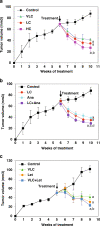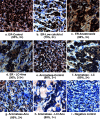Inhibitory effects of calcitriol on the growth of MCF-7 breast cancer xenografts in nude mice: selective modulation of aromatase expression in vivo
- PMID: 21686077
- PMCID: PMC3114631
- DOI: 10.1007/s12672-011-0073-7
Inhibitory effects of calcitriol on the growth of MCF-7 breast cancer xenografts in nude mice: selective modulation of aromatase expression in vivo
Abstract
Calcitriol (1,25-dihydroxyvitamin D(3)), the hormonally active metabolite of vitamin D, exerts many anticancer effects in breast cancer (BCa) cells. We have previously shown using cell culture models that calcitriol acts as a selective aromatase modulator (SAM) and inhibits estrogen synthesis and signaling in BCa cells. We have now examined calcitriol effects in vivo on aromatase expression, estrogen signaling, and tumor growth when used alone and in combination with aromatase inhibitors (AIs). In immunocompromised mice bearing MCF-7 xenografts, increasing doses of calcitriol exhibited significant tumor inhibitory effects (~50% to 70% decrease in tumor volume). At the suboptimal doses tested, anastrozole and letrozole also caused significant tumor shrinkage when used individually. Although the combinations of calcitriol and the AIs caused a statistically significant increase in tumor inhibition in comparison to the single agents, the cooperative interaction between these agents appeared to be minimal at the doses tested. Calcitriol decreased aromatase expression in the xenograft tumors. Importantly, calcitriol also acted as a SAM in the mouse, decreasing aromatase expression in the mammary adipose tissue, while increasing it in bone marrow cells and not altering it in the ovaries and uteri. As a result, calcitriol significantly reduced estrogen levels in the xenograft tumors and surrounding breast adipose tissue. In addition, calcitriol inhibited estrogen signaling by decreasing tumor ERα levels. Changes in tumor gene expression revealed the suppressive effects of calcitriol on inflammatory and growth signaling pathways and demonstrated cooperative interactions between calcitriol and AIs to modulate gene expression. We hypothesize that cumulatively these calcitriol actions would contribute to a beneficial effect when calcitriol is combined with an AI in the treatment of BCa.
Keywords: Aromatase; Aromatase inhibitors; Breast cancer; Calcitriol; Estrogen synthesis; Selective aromatase modulator; Xenografts.
© Springer Science+Business Media, LLC 2011
Conflict of interest statement
The authors declare that they have no conflict of interest.
Figures





Similar articles
-
The potential therapeutic benefits of vitamin D in the treatment of estrogen receptor positive breast cancer.Steroids. 2012 Sep;77(11):1107-12. doi: 10.1016/j.steroids.2012.06.005. Epub 2012 Jul 16. Steroids. 2012. PMID: 22801352 Free PMC article. Review.
-
The effect of combining aromatase inhibitors with antiestrogens on tumor growth in a nude mouse model for breast cancer.Breast Cancer Res Treat. 1999 Sep;57(2):183-92. doi: 10.1023/a:1006225601046. Breast Cancer Res Treat. 1999. PMID: 10598045
-
Biological evidence for dual antiangiogenic-antiaromatase activity of the VEGFR inhibitor PTK787/ZK222584 in vivo.Clin Cancer Res. 2010 Aug 15;16(16):4178-87. doi: 10.1158/1078-0432.CCR-10-0456. Epub 2010 Aug 3. Clin Cancer Res. 2010. PMID: 20682704
-
The effect of second-line antiestrogen therapy on breast tumor growth after first-line treatment with the aromatase inhibitor letrozole: long-term studies using the intratumoral aromatase postmenopausal breast cancer model.Clin Cancer Res. 2002 Jul;8(7):2378-88. Clin Cancer Res. 2002. PMID: 12114443
-
Therapeutic observations in MCF-7 aromatase xenografts.Clin Cancer Res. 2005 Jan 15;11(2 Pt 2):884s-8s. Clin Cancer Res. 2005. PMID: 15701882 Review.
Cited by
-
Obesity and Breast Cancer: Interaction or Interference with the Response to Therapy?Curr Oncol. 2023 Jan 16;30(1):1220-1231. doi: 10.3390/curroncol30010094. Curr Oncol. 2023. PMID: 36661743 Free PMC article.
-
Vitamin D mitigates the adverse effects of obesity on breast cancer in mice.Endocr Relat Cancer. 2016 Apr;23(4):251-64. doi: 10.1530/ERC-15-0557. Epub 2016 Jan 27. Endocr Relat Cancer. 2016. PMID: 26817629 Free PMC article.
-
Vitamin D: an essential adjuvant therapeutic agent in breast cancer.J Int Med Res. 2022 Jul;50(7):3000605221113800. doi: 10.1177/03000605221113800. J Int Med Res. 2022. PMID: 35883275 Free PMC article. Review.
-
Combinations of Calcitriol with Anticancer Treatments for Breast Cancer: An Update.Int J Mol Sci. 2021 Nov 25;22(23):12741. doi: 10.3390/ijms222312741. Int J Mol Sci. 2021. PMID: 34884550 Free PMC article. Review.
-
Vitamin D in Triple-Negative and BRCA1-Deficient Breast Cancer-Implications for Pathogenesis and Therapy.Int J Mol Sci. 2020 May 23;21(10):3670. doi: 10.3390/ijms21103670. Int J Mol Sci. 2020. PMID: 32456160 Free PMC article. Review.
References
Publication types
MeSH terms
Substances
Grants and funding
LinkOut - more resources
Full Text Sources
Research Materials

